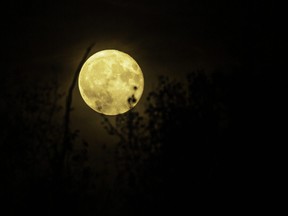The harvest moon will begin lighting up the sky on Thursday night time

For some, leaves altering from vigorous greens to crisp oranges, pumpkin spice cravings and comfortable sweater climate mark the start of autumn. Whereas these are all iconic fall staples, skywatchers get an additional deal with. The harvest moon, the conclusion of this yr’s four-part supermoon collection, will begin lighting up the sky on Thursday night time.
The moon will look a pumpkin-y orange and crimson – which appears oddly becoming – however that isn’t a novel trait to this month. All full moons seem orange – and now we have 13 annually.
What’s a supermoon?
Supermoons are full moons that happen when the moon is on the closest level of orbit to Earth. Supermoons can seem as much as 14 % bigger and 30 % brighter than the smallest-seeming full moon, in keeping with NASA. This would be the final supermoon till subsequent August.
Why is it known as a harvest moon?
The harvest moon, often known as the corn moon by Indigenous teams within the Northeast, traditionally alerts the time of yr when completely different summer time crops are able to be harvested. Farmers have additionally relied on the sunshine from September’s full moon to reap their crops late into the night time.
“It’s near the total harvest, so it’s a full moon that occurs across the time of the autumn harvest,” stated Noah Petro, a scientist with the Lunar Reconnaissance Orbiter Challenge at NASA.
The place and when are you able to see this moon?
Whereas this yr’s harvest moon will seem like a bit bigger and brighter due to its supermoon standing, it’s merely the closest full moon to the autumn equinox.
The autumnal equinox, which leads to practically an equal quantity of daylight and darkness in any respect latitudes, alerts the astronomical turning of seasons – that means cooling temperatures are lastly on the way in which after this blistering summer time. This yr, the harvest moon will rise a couple of week after the autumn equinox, from Thursday night time into Friday morning. The moon will probably be at it’s fullest at 5:57 a.m. on Friday.
We’re all separated by distance however united by the moon and, fortunately, it is a moon that everybody will get to see. Will probably be full from dawn to sundown.
Whereas the harvest moon will start to grace skies on Thursday, don’t fret for those who miss it. Skywatchers, and harvesters, will be capable of see a close to full moon within the days main as much as its month-to-month peak and within the days after, in keeping with NASA ambassador Tony Rice.
“You possibly can go a minimum of a day in both route, perhaps two in every route, and it’s going to look simply as full to most individuals,” Rice stated.